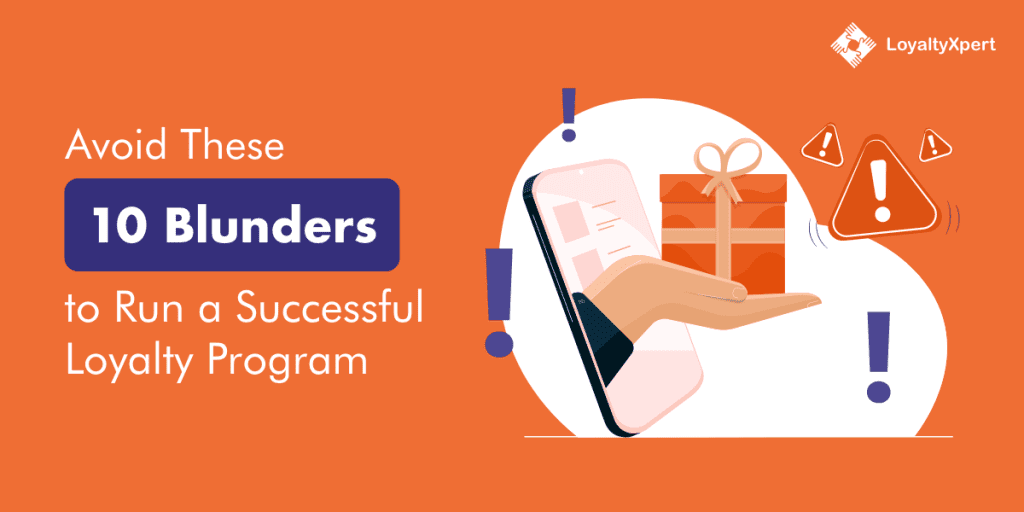Are you planning to run a customer loyalty program for your business? If yes, then it is important to note that customer loyalty programs have evolved over the years. Today’s businesses use these programs for both customer acquisition and retention purposes.
Since customer loyalty programs are largely focused on customers, many businesses mistake creating loyalty or rewards programs about them instead of customers. Various other mistakes in loyalty program management result in unproductive results.
In this blog, you will learn about some of the most common mistakes that businesses usually make while trying to build loyalty. By avoiding these common mistakes, businesses can achieve greater success.
Loyalty program mistakes to avoid
Let’s look at some of the key mistakes that businesses must avoid to reap the benefits of a successful loyalty program.
1. Introduce All The Features and Deals at Once:
The most common mistake most business leaders make is introducing all the biggest loyalty benefits in the first launch of the loyalty program itself. Though making a loyalty program as attractive as possible is necessary, incorporating every possible feature into the launch delays the development process. It makes it tricky and complicated to keep the loyalty program experience full of excitement for customers afterwards.
2. Making Things Complicated:
Making things overly complicated or over-restricted can also affect the success of a loyalty program. If the loyalty logic is not clear or too complicated, customers are likely to leave the program and move ahead to another one.
Besides, keeping the system too simple in the starting and adding restrictions later on will leave customers upset and dissatisfied. Also, limiting the ability of loyalty members to collect points with referrals and reviews to only one time per month reduces their motivation to engage with the loyalty program.
3. Complex Enrollment Process:
The enrollment process is the first step or interaction of customers with your loyalty program. Make sure to keep it as simple as possible. You can provide the link to registration at the bottom or any other suitable place on your brand’s page so that customers can easily find the link and visit the registration page. It is also essential to entice customers to join the program by using attractive images and fonts instead of a plain old, join our loyalty program button.
One more mistake that businesses often make is trying to capture as much data as possible about the customers during the registration process. This is the biggest mistake as many customers doest like filling up all the details. They may stop completing the enrolment if more data is asked from
4. Not Rewarding Engagement:
Most loyalty programs are intended to promote long-lasting engagement and enhance customer lifetime value. Preventing customers from getting too many benefits can restrict the ability of a loyalty program to reach its full potential. Businesses often fail to remind customers to spend their points which also affects the program’s success negatively.
5. Not Paying Attention to the Power of Referrals:
Ignoring or missing out on the power of referrals is another most common mistake that businesses often make. It is important to know that word of mouth plays a powerful role in creating a good business impression.
Customers like to get valuable feedback from their friends or family members about a particular business more than marketing sources. Paying attention to referrals and rewarding members for inviting a certain number of customers can help businesses run their loyalty programs.
6. Mission Out on Omnichannel Strategy:
Nowadays, omnichannel plays a key role in attracting many customers to a business. Letting customers reach businesses via the loyalty journey across multiple channels makes them more satisfied and happy.
Another most important step in loyalty program management is to bring the experience to mobile. If your business already has a business application, it would be better to add a loyalty-related section for a good start.
7. Rewarding Only Transactional Activities:
The next-gen reward programs are focused on engaging customers outside of the buying cycle. It means that customers can earn rewards and points even for their non-transactional activities like writing a product review, being active on social media, filling in survey forms, etc. By rewarding only transactional activities, businesses may miss out on several valuable touchpoints.
8. Not Adding Variety to Loyalty Programs:
Customers like surprises. Businesses must pay attention to adding more and more variety to their programs to keep their customers highly engaged and interested in your loyalty program.
So, how to add variety? Well, you can surprise your customers by giving them rewards on their birthday or by reaching a certain milestone, etc. Surprising and delighting customers can have a great positive impact on customer loyalty than one can imagine.
9. Not Considering Social Media Presence:
Loyalty programs should not be restricted to the membership page alone. By not considering social media, businesses can miss out on various valuable touchpoints with customers. Extending the program’s reach to social media can enhance brand awareness and loyalty program success as well.
10. Not Prepared to Deal With Fraudulent Activities:
Along with loyal members, certain individuals may be looking for an opportunity to take unfair advantage of loyalty programs. Businesses must be prepared to handle any kind of fraudulent activity in the loyalty program management so that loyal customers will not miss the desired rewards.
Conclusion:
By eliminating all these mistakes while considering a loyalty program, businesses can encourage more and more customers to join their program and ultimately gain better outcomes from their loyalty programs. Visit LoyaltyXpert to know more about how to carry out loyalty program management successfully for more profitable results.

